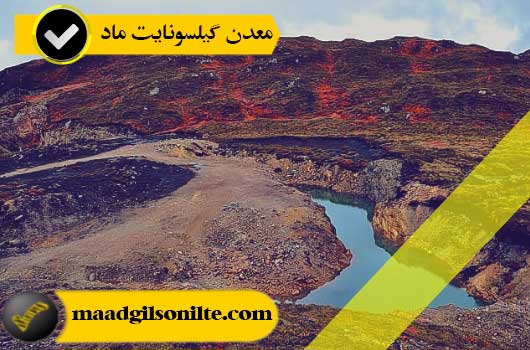
Gilangreb, an area located in Kermanshah province in western Iran, has one of the largest natural bitumen deposits in the world. Known for its high quality and diverse uses, natural bitumen has a long history in the region, with evidence of its use dating back to ancient times. This article examines natural bitumen mines in Gilangarb and highlights geological features, extraction and processing techniques, traditional and contemporary uses, and future prospects and challenges.
Gilangharb, a city in the west of Iran, has one of the largest natural bitumen mines in the world. Natural bitumen, also known as asphalt, is a viscous, black, highly viscous substance that is commonly used in road construction and waterproofing materials. In this article, we examine the history, importance, geology, and mining operations of natural bitumen mines in Gilangarb
Gilangreb is a very important place for the production of natural bitumen due to its extensive reserves and high-quality asphalt. The city is home to one of the largest natural bitumen mines in the world, which has been producing for over a century. Gilan Gharb natural bitumen is also known for its extremely high melting point, which makes it ideal for use in extreme weather conditions.
The primary use of natural bitumen in Gilangarb
The history of using natural bitumen in Gilangreb goes back to ancient times, where there are evidences of its use in building and waterproofing materials. It was also used in medicine and as a sealant for boats and containers.
The impact of natural bitumen on the economy of Gilangarb
The natural bitumen industry has made a significant contribution to the economy of Gilangarb for more than a century. The city’s mines employ thousands of workers and generate millions of dollars in revenue annually. Asphalt produced by Gilangarb is exported to various countries including Japan, China and South Korea.
Continuing the importance of natural bitumen in Gilangarb
The natural bitumen industry in Gilangarb has no signs of slowing down. As demand for asphalt and other bitumen products continues to grow globally, Gilangreb’s unique, high-quality natural bitumen remains a valuable resource.
Geological characteristics of Gilangarb natural bitumen mine
The natural deposits of Gilangharb bitumen are located in the Zagros fold belt, a geological formation that stretches across western Iran. These sediments are found in layers of sandstone and shale and often contain other minerals such as sulfur and magnesium.
Formation of natural bitumen in Gilangarb
The natural bitumen found in Gilangrab has been formed over millions of years from the remains of marine creatures living in this area. With the death of these creatures and their settlement on the ocean floor, layers of sediment were covered, which eventually turned into rocks. Over time, heat and pressure caused the organic matter to turn into natural bitumen.
In general, Gilsonite outcrops of natural bitumen mines of Gilangrab (Gilsonite mud mine) are relatively abundant in Gilangrab region. And in any place where the conditions are suitable in terms of geology and topography, there is a possibility of outcropping of natural bitumen.
Although it seems that in addition to that, there are a number of other Andes that are not yet possible to emerge, or in other words, have not yet reached the surface of the earth. The pattern of Gilsonite outcrops characteristic of natural bitumen mines in Gilangarb region shows that natural bitumen outcrops are under the influence or control of geological and stratigraphic factors.
In this area, on the levels of discontinuities, permeable layers of natural bitumen are usually folded, normal and inverted faults are seen.

The presence of natural bitumen in Qasrshirin and Gilangarb can be explained using plate tectonics. Because this area is affected by the Arabian and Eurasian plates on the one hand, and on the other hand, it exists on the border and margin of these plates.
In these tectonic conditions, which are caused by faults and joints, oil and gas move upwards from reservoirs. Of course, we should pay attention to this point as well, the characteristic of natural bitumen mines in which Gilsonite is observed is more effective than small oil traps and natural bitumens.
which are mostly shallow, under the influence of construction activities, they manage to reach the surface of the earth.
In this way, natural bitumen deposits are located in the West Gilan region and in the so-called Shek Maidan area and the West Gilan River due to the escape of petroleum materials and the settling of semi-solid and pasty petroleum materials in empty spaces and cracks.
There is Gilsonite stored in the gypsum and marl masses of Gachsaran formation. These natural bitumen deposits are the main feature of the natural bitumen mines of Gilan Gharb and are seen in the form of lens-shaped masses with thicknesses from a few centimeters to even 15 meters.
Some other natural bitumen deposits can be seen in Shek Maidan area in the form of streaks with different thicknesses and 20 meters long.
Several factors can affect the quality of Gilangarb natural bitumen. These include the depth and location of the deposits, the composition of the surrounding rock, and the conditions under which the bitumen was formed.
An overview of mining operations in the natural bitumen mines of Gilangarb
Extraction of natural bitumen in Gilangarb usually involves open pit drilling. Asphalt is extracted from the ground using heavy equipment and transported to processing plants for refining.
Processing and refining techniques of Gilangarb natural bitumen
Once natural bitumen is mined, it is transported to processing plants for further refining. The refining process usually involves heating the asphalt to remove impurities and adjusting its chemical composition to meet desired specifications. The resulting product can be used in a wide range of applications, including road construction, roofing and waterproofing.
The natural bitumen of Gilangreb is a unique geological material that has been used for centuries for various uses. One of the most common traditional uses of natural bitumen is for insulation and insulation. It is also used in the production of roofing materials, adhesives and sealants.
In addition to traditional uses, natural bitumen is also used in various industrial uses. It is usually used as an additive in asphalt and road construction, as well as in the production of paints, coatings and plastics.
Traditional uses of natural bitumen are still common in many parts of the world, where it is used for its waterproofing and insulating properties. In some areas, it is even used as a source of fuel for heating and cooking.
In the industrial sector, natural bitumen is increasingly used as an alternative to synthetic materials. It has been found to have excellent adhesion properties and is used in the production of high performance coatings and adhesives.
Recent advances in technology have opened new opportunities for the use of natural bitumen. One of the promising applications in the field of nanotechnology is that it is used in the production of nanocomposites.
In the future, bitumen may be used in the construction of environmentally friendly buildings. Its insulating properties make it an excellent choice for low-energy buildings, and its natural properties make it a sustainable alternative to synthetic materials.
The current situation of natural bitumen industry in Gilangarb
The natural bitumen mines of Gilangreb in Iran are a significant source of natural bitumen that many local businesses and industries rely on for their activities.
However, the industry faces a number of challenges, including the need to improve extraction methods and develop new markets for its products.
Opportunities and challenges of natural bitumen industry in Gilangarb
One of the opportunities of Gilangrab gilsonite industry is the growing demand for sustainable and environmentally friendly building materials. The insulating properties of natural bitumen make it an ideal material for such applications.
However, the industry needs to address concerns about its environmental and health impacts and develop more sustainable extraction and production methods.
The natural bitumen industry of Gilangarb has the potential to grow and evolve in the coming decades. One direction may be toward the development of new markets and applications for natural bitumen, such as the production of high-performance coatings and adhesives.
Another direction is towards the adoption of more sustainable and environmentally friendly methods in the extraction and production of natural bitumen, which helps to address concerns about its environmental and health effects. It is the source of economic activity and cultural heritage in the region. As technologies and industries evolve, the future of natural bitumen remains uncertain, but ongoing research and development in the field indicates that this valuable resource will continue to play an important role in various industries around the world.

